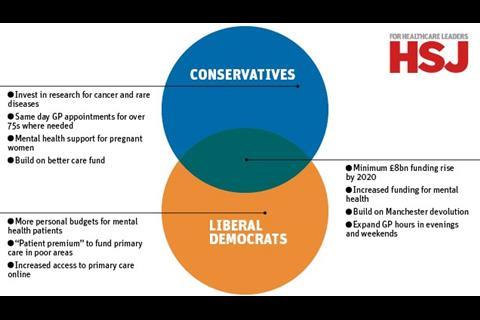With two weeks to go until the general election, the NHS is a top priority for voters, and all the main parties have set out their key health policy pledges in their manifestos.
The two diagrams above show where the parties’ health policy promises do and do not overlap. With the election on 7 May likely to result in a hung Parliament, any common ground on the NHS may be a vital factor in post-election negotiations between parties, and in what policies emerge.
The graphics focus on two possible scenarios. The first explores the common ground between Labour, the Liberal Democrats and the Scottish National Party – a triumvirate many experts believe will have to work together in some form after 8 May. The second examines Conservative policies compared with those of their current coalition partners the Liberal Democrats.
The diagrams are based on pledges published as part of each party’s manifesto. They are not exhaustive - not all policies are listed.
Both diagrams show there is universal support for increased spending on mental health, and, with the Liberal Democrats’ commitment to repealing any parts of the Health Act 2012 which make NHS services “vulnerable to forced privatisation”, there is also now clear convergence on the Left on this issue.
But the Liberal Democrats are not only positioning themselves as a new ally for Labour. If the Conservative/Lib Dem coalition were reprised, it could start work quickly with fully funding the NHS Five Year Forward View, investing in mental health, and exploring further options for devolution.




























4 Readers' comments